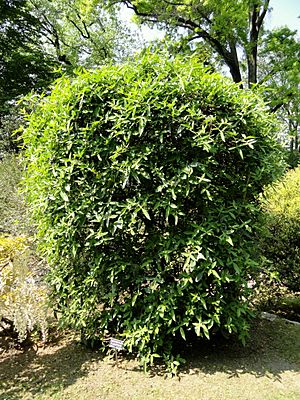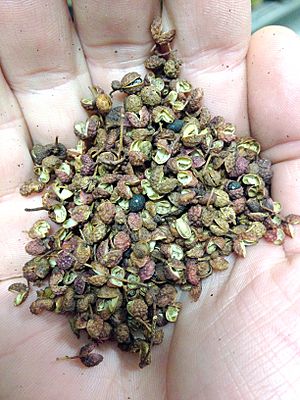Winged prickly ash facts for kids
Quick facts for kids Winged prickly ash |
|
|---|---|
 |
|
| Scientific classification | |
| Genus: |
Zanthoxylum
|
| Species: |
armatum
|
Zanthoxylum armatum, also known as winged prickly ash or rattan pepper, is a type of plant in the citrus family, Rutaceae. This plant is a shrub that loses its leaves every year (deciduous). It has thorns and can grow up to about 3.5 meters (11.5 feet) tall.
You can find Zanthoxylum armatum growing naturally from Pakistan all the way to Southeast Asia, and even up to Korea and Japan. It's famous for being one of the plants that gives us the spice called Sichuan pepper. People also use it in traditional medicine, to make special oils, and sometimes grow it in gardens because it looks nice.
Contents
What Does It Look Like?
This plant can grow as a woody vine, a shrub, or even a small tree, reaching up to 3.5 meters (11.5 feet) tall. It's a deciduous plant, meaning it sheds its leaves each year. Its leaves are usually opposite each other and can be shaped like a spear (lanceolate), an egg (obovate), or an oval (elliptic).
Both the young branches and the leaves have small thorns or spines. A special feature of this plant is that the stem of its leaves has "wings" up to 6 millimeters (0.24 inches) wide on each side. This is why it's called "winged prickly ash" and helps tell it apart from other similar plants.
The flowers have yellow parts that produce pollen (anthers). The female parts of the flowers (gynoecium) have 1 to 3 sections (carpels). When the plant produces fruit, they are purplish-red and about 4-5 millimeters (0.16-0.2 inches) wide. Inside, the seeds are black and about 3-4 millimeters (0.12-0.16 inches) in size.
In China and Nepal, the shrub usually flowers from April to May. In Nepal, you can find its fruit all year round, while in China, the fruit appears from August to October. In India, it flowers a bit earlier, from March to April.
How It Was Named
The famous Swiss botanist Augustin Pyramus de Candolle was the first to describe this plant in 1824. This is how it got its scientific name, Zanthoxylum armatum.
Where It Grows
This small tree is native to many parts of East and Southeast Asia, as well as the northern Indian subcontinent. It has also started growing naturally in some other places.
You can find Zanthoxylum armatum in countries like:
- Japan and the Ryūkyū Islands
- Korea
- Many regions of China, including Anhui, Fujian, Guangdong, Guangxi, Guizhou, Hubei, Hunan, Jiangsu, Jiangxi, Shaanxi, Shandong, Sichuan, Tibet, Yunnan, and Zhejiang
- Northern Taiwan
- Philippines
- Vietnam, Laos, Thailand, Myanmar, Bangladesh
- India, including Assam
- Bhutan, Nepal
- The Eastern and Western Himalayas, Kashmir, and Pakistan
It might also be found in Indonesia. It has even spread to Northeast Argentina and the North Caucasus region.
Where It Lives and Its Environment
Zanthoxylum armatum can grow in many different natural environments, from sea level up to about 3100 meters (10,170 feet) high.
For example, in the Salyan District, Nepal, this shrub grows under taller trees in pine forests (like Pinus roxburghii). It also grows in oak forests, alongside plants like Rhododendron arboreum. Birds enjoy eating the fruits of Z. armatum, and by doing so, they help spread the plant's seeds far and wide.
Different Names for the Plant
Z. armatum has many different names depending on the language and region.
In China, the plant and its fresh berries are called téngjiāo (藤椒). The dried seeds are known as qinghuajiao (青花椒) or majiao (麻椒).
Other names include:
- Qanadlı zantoksilum (Azerbaijani)
- Dambara (Pashto)
- तेजफल tejphal, darmar, tumru, timroo, trimal (Hindi)
- ꯃꯨꯛꯊ꯭ꯔꯨꯕꯤ mukthrubi (Manipuri)
- तिमुर timur (Tamil)
- konda-kasimi (Telugu)
- ಜಿಮ್ಮೀ jimmi (Kannada)
- തൂമ്പണലരി (Malayalam)
- hokum (Adi)
- ganya (Angami)
- winged prickly ash, prickly ash, toothache tree, yellow wood, suterberry (English)
- tumbru, tejbal (other names in India)
- arhrikreh (Mizo)
- टिमुर timur (Nepali)
- หมักก้าก, hui-jiao (Thai)
- Sẻn gai (Vietnamese)
- 竹叶花椒, 毛竹叶花椒, zhu ye hua jiao (Standard Chinese)
- flügelstachelige Stachelesche (German)
How People Use It
The fruit and seeds of Zanthoxylum armatum are used as a spice called Sichuan pepper. The bark, fruit, and seeds are also used in traditional medicines in India, Nepal, and Thailand.
This plant is also a source of a special oil called Wartara Oil. Because of its appearance, the shrub is sometimes grown in gardens as an ornamental plant, meaning it's grown for its beauty.
In the Silyan district of Nepal, parts of the plant used in medicine are often collected and sent to India. These plants grow in different types of land, including government-controlled, community-controlled, and private areas. This means how they are harvested and managed can vary a lot.
See also
 In Spanish: Zanthoxylum armatum para niños
In Spanish: Zanthoxylum armatum para niños


